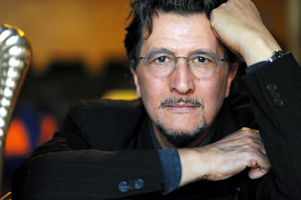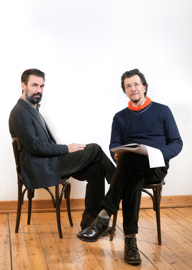Interview with Federico Tiezzi, director of “Freud or the interpretation of dreams” on stage in Milano from 23 January to 11 March 2018
By Maria Grazia Vassallo Torrigiani
“We are such stuff as dreams are made on”, says Prospero in Shakespeare’s The Tempest
Freud, the father of psychoanalysis investigated ‘the stuff of dreams’ - I mean the ‘materials’ and the ‘rules’ dreams are built on- to elucidate how the unconscious mind creates the nocturnal, illusory, fictional world where we can find the emotional truth and the real meaning of our human experience. Every night the unconscious, as it were a playwright or a director, stages an enigmatic play on our mind’s theatre, using our memories, conflicts, anxieties and wishes as characters and stage tools. At the beginning of the last century Freud stated that the dream was the ‘royal road’ for the study of the unconscious life, and even though contemporary psychoanalysis looks at the oneiric from slightly different perspectives, dreams still play a central role in psychoanalytic theory and practice.
A new production - Freud or the Interpretation of Dreams, at the Piccolo Teatro Strehler, Milano - deals precisely with that ‘stuff’. Federico Tiezzi, a renowned Italian director, Stefano Massini, a brilliant playwright who adapted Freud’s text for the stage, and a great Fabrizio Gifuni in the role of Freud are the moving spirits behind this production.
“During the play” – I quote Massini from the Piccolo’s playbill – “Freud analyzes dreams, he recalls in certain sessions with his patients at the psychiatric clinic or in his Vienna studio, and speaks of his own dreams. The way in which these characters are presented by Freud is a sort of mosaic of clinical cases and characters each of which presenting an enigma”.

We interviewed Federico Tiezzi to learn more on how he used the “stuff” of his creative imagination to create this interesting and fascinating play.
Maestro Tiezzi, lie down on the couch and tell us how you got to this piece on Freud. At the beginning of your career, in 1976, you staged “Lo spirito del giardino delle erbacce” (The spirit of the weed garden), a play inspired by a clinical case of Roland D. Laing. So the interest in psychoanalysis could be traced back to your early artistic life, offering you suggestions and insights for your work and creating stories and characters. Could you elaborate on that?
Yes, indeed, you brought to mind the title of quite an early play of mine, which was inspired by Ronald Laing. Psychoanalysis has always interested me. My early supporters were on one hand artists and visual arts critics, and on the other psychoanalysts. Mingling with intellectuals of different disciplines and artistic languages was very common in the ’Seventies and ’Eighties. Artists were intent on destroying the borders which confined creative people to their own specific areas. Laing was very popular among our generation and he became a sort of tutelary guardian, above all thanks to his book The Divided Self which became a liberation banner. My work, Lo spirito del giardino delle erbacce, a visual and silent play, was inspired not only by one of Laing’s clinical cases but also by Hieronymus Bosch’s painting at the Prado Museum called The Garden of Earthly Delights. In those days it was de rigueur first to read Foucault’s Madness and Civilization, and then The History of Sexuality, the Anti-Oedipus by Guattari and Rizoma by Deleuze. One of the founding myths of Freudian psychoanalysis can be found in Sophocles’ Oedipus Rex - defined by Aristotle as ‘the perfect tragedy’.
Freud entered my life at an early stage. I read Psychopathology of Everyday Life, and The Interpretation of Dreams in second year at high school: this was a seminal book that introduced me into the secrets of the unconscious. Since then, the words ‘Latent’ and ‘Manifest’ have been part of my work of text analysis: there is a manifest text and a latent text, a repressed one. The latter I have to bring to the light, so it becomes conscious.
This secret, cryptic, sunken text – often repressed from the historical consciousness of the text- is what I work on. For example, it doesn’t mean ‘to psychoanalize’ Shakespeare’s Hamlet but to work on bringing to the surface the conflicts, the anxious search for identity, the linguistic structure that- in my opinion- is as important as the contents embodied in the text itself. I worked on Hamlet for four years, and I created four plays that were staged all over Europe. Now I’m going to work on Oedipus Rex, a tragedy on the origins of language, in other words, the origins of the world.

And now to “Freud and the Interpretation of Dreams”. What was it that attracted you to this project? What does it mean to stage Freud’s work today to contemporary audiences?
The passion I’m putting into this project comes from finding myself face to face with Freud. For years I have been musing over a mise en scène of this book. For one reason or another I always postponed it. Then, the Piccolo Teatro of Milan asked me to create a play based on some material that Stefano Massini had put together, inspired by The Interpretation of Dreams.
Massini’s intention was to reinvent and resolve dramaturgically some ideas in The Interpretation of Dreams and also narrate the discovery of the psychoanalytic method by Freud. It is fiction, of course; but, on the other hand, what else is the theatre? Massini’s text is a long monologue by Freud while he progressively unearths the rules of dreams and their own particular language. I edited these texts by Massini, to show how Freud’s identity as a scientist and as a man progressively takes shape.
Reading The Interpretation again after many years, I’ve come to consider it an extraordinary autobiography of the author, where a crucial role is played by Sigmund’s father, Jacob. In my editing of the material I merged and switched some scenes so as to give an absolute centrality to this ‘liberation’ from Jacob, the father. Fabrizio Gifuni plays Freud: his work on the character is really impressive! Sometimes he strikes you as Freud himself coming to life from the shadows of our collective memory!
A theatrical director doesn’t just “obey” the script, but he adds further dimension and perspectives to it. Which were your personal keys to Massini’s text? And how did you envision Freud as a character of this play?
I applied the same method of manifest text/latent text that I used on Pirandello’s texts some years ago. The dramatic composition was accomplished together with Fabrizio Sisini. The work was particularly demanding, we had to show through dialogues and reports of clinical settings, a structure which was able to convey a different meaning. In other words, the meaning of Freud’s voyage, the ‘rites of passage’, the discovery of his own identity and the liberation from his father. I had to strip Massini’s text of the positive aspects and introduce a man in crisis who gathers failures along with achievements: in short, a human being. We find ourselves in Freud’s mind, where his memories are his patients who are dreaming of themselves and of other patients, and all are dreaming of Sigmund Freud.
In the end we don’t find out who’s dreaming of who…
In the context of the theatrical avant-garde of the seventies, when still an art student at the University of Florence, you founded your first theatre company with the performers Sandro Lombardi and Marion D’Amburgo. Refusing the traditional theatre conventions, since then you have been developing an innovative theatrical language that meets the language of the visual arts- and of music and poetry as well. Which visual suggestion- or music or whatever- did inspire you in creating the ‘emotional space’ for this piece on Freud?
I was educated as an art historian, specializing in Late-Gothic, but in this particular case, besides the visual arts which are my constant reference point, my attention is drawn to cinema and music, Movies – from John Huston to Lynch’s hallucinated landscapes - give me a way for interpreting material which is more akin to a film script (I’m thinking of the great Irving Stone) than to theatrical text. In this work, the visual arts are represented by a magnificent opening curtain created by Giulio Paolini, symbolizing the march of mankind to perfection.
On one side, we see a man holding his head in his hands, he has a beard, it could be Freud; images of seventeenth century perspectives criss-cross over him…
Let me ask you a final and fundamental question: did you have any significant dream during these months of hard work about Freud and his interpretation of dreams?
Very many dreams; but I only remember a small part …